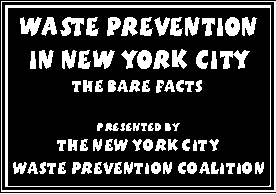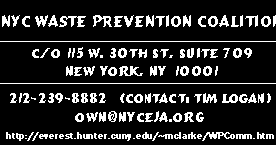

New York City’s garbage export policy has quadrupled the City’s waste disposal costs since 1998. Costs are expected to double again within 2 years. The waste management budget is approaching $1 billion!*
* http://www.ibo.nyc.ny.us/newsfax/insidethebudget77.pdf
Do we have to export so much?
No! The clear alternative is investment in measures to reduce waste.
Waste Prevention
- Saves Money; Saves Energy
The Issue:
New York City is increasingly exporting vast amounts of solid waste at escalating costThe Solution:
Waste Prevention is the most cost-effective, socially responsible, and environmentally sound method of addressing our waste problem.The Problem:
Too Much ExportIn March of 2001, the Fresh Kills Landfill on Staten Island, officially closed for municipal waste. The City now exports approximately 11,400 tons per day of residential and institutional solid waste to landfills and incinerators in other states. This is in addition to 27,000 tons per day of commercial waste, much of which has been exported for over a decade. Thus over 3 million additional tons per year of NYC’s waste will need to be transported to and disposed of at out-of-city landfills and incinerators.
Costs are Skyrocketing*
The cost of transferring, transporting, and disposing of the City’s waste stream has grown from $578 million in 1997 to $996 million projected for 2001, and is projected to reach $1 billion by 2003. $300 million of this is for export. These dramatically increasing costs compete with schools, social services, and other essential services for our scarce tax dollars.
* NYC Independent Budget Office
Environmental and Public Health Costs
The current "interim" system for exporting solid waste also has severe public health impacts, due in part to an estimated 425,000 extra trips each year by diesel exhaust-spewing garbage trucks, substantially raising pollution levels in predominantly low-income and minority neighborhoods along the routes and around transfer stations. There are also significant environmental impacts from solid waste disposal including generation of toxic gases and global-warming greenhouse gases.
Managing such huge volumes of waste also hcauses substantial regional and global environmental problems associated with the extraction, manufacture, and transport of excess goods and packaging, impacting on natural resources, energy and materials use, and on global warming. If just one household generated 5% less waste, and then recycled what remained, 309 pounds of carbon equivalent could be reduced.* For New York City this equates to 538,000 tons of carbon equivalent (or 403,500 fewer cars on the road).
*http://www.epa.gov/globalwarming/actions/waste/whatis.html#balance
The Solution
Is Waste PreventionWaste prevention means a reduction in the volume and the toxicity of solid waste. This is a proactive solid waste strategy that gets to the source of the problems facing New York and other cities by stopping waste before it’s created.
The City spends less than $5 million per year on waste prevention initiatives as compared with $300 million for export. Waste export, not counting collection, costs $95 per ton. Waste prevention in New York City has cost only $27 / ton for programs implemented in the 1990s according to Department of Sanitation research.* Waste prevention programs also reduce collection costs as much as $100/ton.
* SAIC Waste Prevention Research, 2000
In 1992 the City committed to reduce its solid waste by 10% by 2000. At a savings of $65/ton over export, a reduction of 1100 tons per day of waste would amount to a savings of $71,500/day or well over $20 million per year. Adding in savings for avoided collection costs shows that investments in waste prevention pay off. DOS predicted that reduction of 600,000 tons a year would reduce collection costs by over $26 million in 2000 (because the number of truck shifts would be reduced by 4 to 5%).
Individuals, businesses, and government agencies can practice waste prevention by:
Reusing, repairing, renting, borrowing, sharing, or donating usable goods instead of throwing them away.
Buying waste-preventing products, such as copiers that can print double-sided, and products with long warranties.
Buying products with less packaging. Containers and packaging make up one-third of municipal waste in the U.S., by weight, and one-half by volume
Buying reusable alternatives to disposable products.
Buying non- or less-toxic products.
Encouraging product and packaging designers and manufacturers to design for durability, reuse, repair, and recycling.
What are the Benefits of Waste Prevention?
Waste prevention will:
What can elected officials do to reduce waste export and save the City
money? Realize that investments in waste prevention are not only the most
fiscally conservative, but are the most environmentally sound solutions to our increasing
solid waste problems. Insist that waste prevention be the top management strategy in solid
waste management planning. Look for ways to increase budget allocations for waste prevention. Support ongoing investments in pilot tests of innovative waste
prevention initiatives. Fund research to find the nation’s most successful municipal
waste prevention programs, and adapt them to New York City. Institute ongoing multi-media, multi-approach waste prevention
educational initiatives to reach every New Yorker. Invest in expansion of the successful "Recycle-A-Bicycle"
program for vocational training of city school students to repair other durable products
(e.g. computers, electronics, and furniture). Support trials of pay-as-you-throw programs in NYC. Thousands of
communities enthusiastically support these programs because they have increased waste
reduction and recycling, saving their communities millions of dollars. For more info: Talk
to the NYC Waste Prevention Coalition or see EPA’s website: http//www.epa.gov/payt/index.htm
Support permanent improvements in the solid waste management planning process, such that sufficient new innovative programs, incentives, and legislation, are required for each year in the planning timeframe to achieve 10% reduction in the waste stream by 2005.
Support City Council’s Intro 482. This bill requires NYC agencies to implement waste prevention in their own operations, purchase recycled-content products and waste-preventing goods and services.
Expand onsite composting programs and organic waste prevention citywide to include food waste, as well as yard waste.
Institute quantity-based user incentives in all City agencies and institutions that get free garbage collection from the City.
Provide waste prevention information and technical assistance to all businesses and health care facilities.
Support purchase of modern computers and a computer database to enable tracking of all City purchases and of reusable equipment and supplies available at various agencies.
Expand technical & economic development assistance for waste-reducing businesses (e.g., re-manufacturers of used computers, shipping pallets, and toner cartridges.)
Provide waste prevention information and technical assistance to all businesses.
Expand Materials for the Arts, a materials and resource exchange currently limited to certain artists and nonprofits, to a citywide program with locations in all boroughs, along with curbside pickup, permitting all residents, institutions and businesses to participate.
Expand New York WasteMatch’s citywide waste exchange, waste reduction and materials management programs.
Work with food chains and other retailers to conduct ongoing environmental shopping campaigns to educate consumers.
Support funding for administration-level waste prevention coordinators in all City agencies and institutions that receive free garbage collection from the City and implement baseline waste audits.
Want to know more? Please contact:
